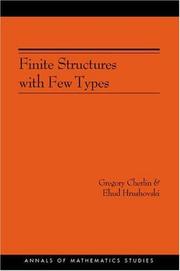| Listing 1 - 3 of 3 |
Sort by
|
Book
ISBN: 1400881226 9781400881222 9780691161693 9780691161686 0691161682 9780691161686 0691161690 9780691161693 Year: 2016 Publisher: Princeton, NJ
Abstract | Keywords | Export | Availability | Bookmark
 Loading...
Loading...Choose an application
- Reference Manager
- EndNote
- RefWorks (Direct export to RefWorks)
Over the field of real numbers, analytic geometry has long been in deep interaction with algebraic geometry, bringing the latter subject many of its topological insights. In recent decades, model theory has joined this work through the theory of o-minimality, providing finiteness and uniformity statements and new structural tools. For non-archimedean fields, such as the p-adics, the Berkovich analytification provides a connected topology with many thoroughgoing analogies to the real topology on the set of complex points, and it has become an important tool in algebraic dynamics and many other areas of geometry. This book lays down model-theoretic foundations for non-archimedean geometry. The methods combine o-minimality and stability theory. Definable types play a central role, serving first to define the notion of a point and then properties such as definable compactness. Beyond the foundations, the main theorem constructs a deformation retraction from the full non-archimedean space of an algebraic variety to a rational polytope. This generalizes previous results of V. Berkovich, who used resolution of singularities methods. No previous knowledge of non-archimedean geometry is assumed. Model-theoretic prerequisites are reviewed in the first sections.
Tame algebras. --- Algebras, Tame --- Associative algebras --- Abhyankar property. --- Berkovich space. --- Galois orbit. --- Riemann-Roch. --- Zariski dense open set. --- Zariski open subset. --- Zariski topology. --- algebraic geometry. --- algebraic variety. --- algebraically closed valued field. --- analytic geometry. --- birational invariant. --- canonical extension. --- connectedness. --- continuity criteria. --- continuous definable map. --- continuous map. --- curve fibration. --- definable compactness. --- definable function. --- definable homotopy type. --- definable set. --- definable space. --- definable subset. --- definable topological space. --- definable topology. --- definable type. --- definably compact set. --- deformation retraction. --- finite simplicial complex. --- finite-dimensional vector space. --- forward-branching point. --- fundamental space. --- g-continuity. --- g-continuous. --- g-open set. --- germ. --- good metric. --- homotopy equivalence. --- homotopy. --- imaginary base set. --- ind-definable set. --- ind-definable subset. --- inflation homotopy. --- inflation. --- inverse limit. --- iso-definability. --- iso-definable set. --- iso-definable subset. --- iterated place. --- linear topology. --- main theorem. --- model theory. --- morphism. --- natural functor. --- non-archimedean geometry. --- non-archimedean tame topology. --- o-minimal formulation. --- o-minimality. --- orthogonality. --- path. --- pro-definable bijection. --- pro-definable map. --- pro-definable set. --- pro-definable subset. --- pseudo-Galois covering. --- real numbers. --- relatively compact set. --- residue field extension. --- retraction. --- schematic distance. --- semi-lattice. --- sequence. --- smooth case. --- smoothness. --- stability theory. --- stable completion. --- stable domination. --- stably dominated point. --- stably dominated type. --- stably dominated. --- strong stability. --- substructure. --- topological embedding. --- topological space. --- topological structure. --- topology. --- transcendence degree. --- v-continuity. --- valued field. --- Γ-internal set. --- Γ-internal space. --- Γ-internal subset.

ISBN: 0691113327 Year: 2003 Publisher: Princeton Princeton University Press
Abstract | Keywords | Export | Availability | Bookmark
 Loading...
Loading...Choose an application
- Reference Manager
- EndNote
- RefWorks (Direct export to RefWorks)
Book
ISBN: 9780521889810 9780511546471 9780521335157 0511546475 9780511371042 0511371047 0521889812 9786611156237 6611156232 9780511370038 0511370032 1107187664 0511369026 128115623X 0511370571 0511369514 0521335159 Year: 2007 Volume: 30 Publisher: Cambridge Cambridge University Press
Abstract | Keywords | Export | Availability | Bookmark
 Loading...
Loading...Choose an application
- Reference Manager
- EndNote
- RefWorks (Direct export to RefWorks)
This book addresses a gap in the model-theoretic understanding of valued fields that had limited the interactions of model theory with geometry. It contains significant developments in both pure and applied model theory. Part I of the book is a study of stably dominated types. These form a subset of the type space of a theory that behaves in many ways like the space of types in a stable theory. This part begins with an introduction to the key ideas of stability theory for stably dominated types. Part II continues with an outline of some classical results in the model theory of valued fields and explores the application of stable domination to algebraically closed valued fields. The research presented here is made accessible to the general model theorist by the inclusion of the introductory sections of each part.
Model theory --- Valued fields --- Domination (Graph theory) --- Model theory. --- Valued fields. --- Graph theory --- Fields, Valued --- Topological fields --- Logic, Symbolic and mathematical
| Listing 1 - 3 of 3 |
Sort by
|

 Search
Search Feedback
Feedback About UniCat
About UniCat  Help
Help News
News